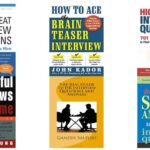Table of Contents:
Brainteaser Interview Questions – Complete Guide with Examples
Brainteaser interview questions are designed to test your logical reasoning, analytical thinking, and creativity rather than your memorized knowledge.
These questions are often used in HR rounds for consulting, technology, finance, and management roles to evaluate how candidates think under pressure and solve unfamiliar problems.
In this complete guide, we’ll explore the most popular brainteaser questions, strategies to answer them, and sample answers that demonstrate clarity and confidence.
Why HR Uses Brainteaser Questions
HR professionals use brainteasers to observe how you:
- Analyze a problem logically
- Break down complex information into smaller parts
- Think creatively beyond standard answers
- Stay calm and positive when faced with challenges
These questions don’t always have one “correct” answer. The interviewer is interested in your thought process, not just your final response.
How to Answer Brainteaser Questions in Interviews
To handle such questions effectively, follow this 4-step approach:
- Clarify the problem – Restate the question to confirm understanding.
- Think aloud – Explain your reasoning process.
- Break it into parts – Use logic or estimations where needed.
- Provide a conclusion – Share a clear, reasoned answer confidently.
Popular Brainteaser Interview Questions and Answers
Here are some common examples of brainteaser questions you might encounter during an HR interview, with sample answers to guide you.
1. The Elevator Problem
Question:
A man lives on the 10th floor. Every day he takes the elevator to the ground floor to go to work. When he returns, he only rides up to the 7th floor and then walks the rest of the way. Why does he do this?
Answer:
He is too short to reach the button for the 10th floor. He presses the 7th-floor button instead and walks up the remaining floors.
HR Insight:
This question checks creative problem solving and attention to unusual details.
2. The Weighing Puzzle
Question:
You have 8 identical-looking balls. One of them is slightly heavier. How can you find the heavier ball using a balance scale in just 2 weighings?
Answer:
Divide the balls into 3 groups: 3, 3, and 2. Weigh the first two groups.
- If one side is heavier, take those 3 and weigh any 2 of them.
- If equal, the heavier one is in the group of 2 — weigh them directly.
HR Insight:
Tests strategic reasoning and efficiency in problem-solving.
3. The Clock Hands Puzzle
Question:
How many times in a 12-hour period do the hands of a clock overlap?
Answer:
The hands overlap approximately every 65 minutes, so they coincide 11 times in 12 hours.
HR Insight:
This checks your logical estimation and mathematical thinking.
4. The Apple Division Question
Question:
You have 3 apples and 4 people. How can you divide them equally without cutting any apple?
Answer:
Convert the apples into juice and then divide it equally among the 4 people.
HR Insight:
Evaluates creative problem solving and thinking beyond literal meanings.
5. The Bridge Crossing Puzzle
Question:
Four people must cross a bridge at night. Only one flashlight is available. At most, two people can cross at a time, and they must have the flashlight to see. Their times are 1, 2, 7, and 10 minutes respectively. What is the minimum total time required for all to cross?
Answer:
The minimum total time is 17 minutes using optimal pairing and flashlight return logic.
HR Insight:
Tests analytical reasoning and strategic planning.
6. Logical Business Question
Question:
If you were offered two job options — one with a higher salary but less learning, and one with a lower salary but high growth potential — which would you choose?
Answer:
“I would choose the position that offers more learning and growth because it ensures long-term professional development, which will eventually lead to higher rewards.”
HR Insight:
Evaluates decision-making ability and career perspective.
7. Riddle-Based Brainteaser
Question:
A car is moving north at 60 km/h, and the wind is blowing east at 60 km/h. In which direction does the smoke from the car go?
Answer:
There’s no smoke — the car is electric.
HR Insight:
Tests attention to detail and ability to catch trick wording.
Proven Strategies to Master Brainteaser Questions
- Think logically, not emotionally — interviewers value reasoning.
- Ask clarifying questions if something is ambiguous.
- Stay calm even if you don’t immediately know the answer.
- Demonstrate process thinking rather than guessing randomly.
- Use structure — break complex questions into smaller parts.
brainteaser interview questions, logical interview puzzles, tricky HR interview questions, problem solving interview answers, creative thinking questions, HR puzzle round, brain teaser examples for interviews, reasoning interview questions and answers, smart HR questions, critical thinking interview preparation
Common Mistakes to Avoid
❌ Jumping straight to an answer without reasoning
❌ Getting frustrated or defensive during tricky puzzles
❌ Ignoring the question’s details or assumptions
❌ Overcomplicating simple logical questions
Sample Real-Life HR Brainteasers from Top Companies
Google Interview Example:
“How many golf balls can you fit into a Boeing 747?”
→ Expected Approach: Estimate the plane’s volume, subtract seating, and calculate based on ball size.
Microsoft Interview Example:
“Why are manhole covers round?”
→ Answer: Because a round cover won’t fall into the hole, can be rolled easily, and fits in any orientation.
Amazon Interview Example:
“If you were asked to improve the company’s delivery time by 10%, what would you do first?”
→ Answer: Analyze current bottlenecks, optimize routes, and use predictive analytics for demand planning.
Tips to Impress Interviewers with Brainteaser Answers
✅ Always explain your thinking process clearly.
✅ Visualize solutions — draw or outline your reasoning if allowed.
✅ Relate answers to real business logic whenever possible.
✅ Stay positive — interviewers prefer confident and curious minds.
FAQs – Brainteaser Interview Questions
Q1: Are brainteasers still common in HR interviews?
Yes, especially in consulting, IT, and analytical job profiles.
Q2: How can I prepare for brainteaser questions?
Practice logic puzzles, riddles, and math-based reasoning questions regularly.
Q3: What’s more important — the correct answer or reasoning?
Reasoning is more important. Interviewers assess how you approach problems.
Q4: Should I guess if I don’t know the answer?
Yes, but make it an educated guess by showing logical steps.
Q5: Do brainteasers test intelligence or creativity?
They test both — primarily how you apply logic creatively under pressure.



